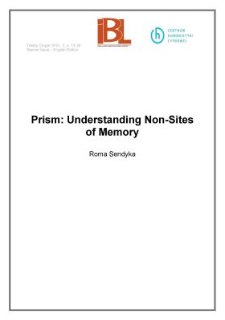- Search in all Repository
- Literature and maps
- Archeology
- Mills database
- Natural sciences
Advanced search
Advanced search
Advanced search
Advanced search
Advanced search

Object
Title: Prism: Understanding Non-Sites of Memory
Subtitle:
Vol. 2 (2015) - Special Issue - English Edition
Publisher:
Place of publishing:
Description:
21 cm ; Pol. text, eng. summary
Type of object:
References:
1. G. Agamben, Remnants of Auschwitz: The Witness and the Archive, trans. D. Heller-Roazen (Zone Books: New York, 1999).
2. E. van Alphen, Armando: Shaping Memory (Rotterdam: NAi Publishers, 2000).
3. M. Auge, Non- Places: An Introduction to Supermodernity, trans. J. Howe, 2nd edition (London: Verso, 2009).
4. U. Baer, Spectral Evidence: The Photography of Trauma (Cambridge: MIT Press, 2002).
5. J. Beinek, “Inscribing, Engraving, Cutting: The Polish Romantic Album as Palimpsest,” in The Effect of Palimpsest: Culture, Literature, History, edited by B. Shallcross and R. Nycz ( Frankfurt am Main: Peter Lang, 2011).
6. R. Brody, “Claude Lanzmann on ‘Shoah,’” The New Yorker (December 10 2010), http://www.newyorker.com/online/blogs/movies/2010/12/claude-lanzmann-on-shoah.html;
7. E. E. Burriss, Taboo, Magic, Spirits: A Study of Primitive Elements in Roman Religion (New York: Macmillan, 1931).
8. D. Chakrabarty, “The Climate of History: Four Theses,” Critical Inquiry 2 (2009): 197-222.
9. J. Culler, “Junk and Rubbish: A Semiotic Approach,” Diacritics 15 (Fall 1985): 2-13.
10. T. DeNora, After Adorno: Rethinking Music Sociology (Cambridge: Cambridge University Press, 2003).
11. P. Desbois, The Holocaust by Bullets: A Priest’s Journey to Uncover the Truth behind the Murder of 1.5 Million Jews (New York: Palgrave Macmillan, 2009).
12. G. Didi-Huberman, Phasmes: essais sur l’apparition (Paris: Minuit, 1995).
13. G. Didi-Huberman, “The Site, Despite Everything,” trans. S. Liebman, in Claude Lanzmann’s Shoah: Key Essays, ed. S. Liebmann (Oxford: Oxford University Press 2007).
14. F. Gantheret, “L’Entretien de Claude Lanzmann, Les non-lieux de mémoire,” Nouvelle Revue de Psychanalyse 33 (1986): 293–305.
15. R. Kotarba, Niemiecki obóz w Płaszowie 1942–1945 (Warsaw–Krakow: Instytut Pamięci Narodowej, 2009), 161–175.
16. D. LaCapra, “Lanzmann’s ‘Shoah’: ‘Here There Is No Why,’” Critical Inquiry 2 (1997): 231-269.
17. C. Lanzmann, “Le Lieu et la parole,” Au sujet de Shoah: Le Film de Claude Lanzmann, ed. M. Deguy (Paris: Éditions Berlin, 1990).
18. C. Lanzmann, Patagonian Hare: A Memoir, trans. F. Wynne (New York: FSG, 2013).
19. S. Liebman, Claude Lanzmann’s Shoah: Key Essays (Oxford: Oxford University Press, 2007).
20. J. Małczyński, “Drzewa—Żywe pomniki w Muzeum-Miejscu Pamięci w Bełżcu,” Teksty Drugie 1–2 (2009): 208-214.
21. M. P. Markowski, “Wiping Out: The Palimpsest, the Subject, and the Art of Forgetting,” edited by B. Shallcross and R. Nycz (Frankfurt am Main: Peter Lang, 2011).
22. P. Nora, “Between Memory and History: Les Lieux de Mémoire,” Representations 26 (1989): 7-24.
23. D. Reinartz, Deathly Still: Pictures of Former Concentration Camps (New York: Scalo Publishers, 1995).
24. Z. Reshi, S. Tyub, Detritus and Decomposition in Ecosystems (Delhi: New India Publisher 2007).
25. I. Sample, “Firm Plans Human DNA Tree Memorial,” The Guardian (April 30, 2004), accessed 28 July 2012, http://www.theguardian.com/science/2004/apr/30/genetics.highereducation.
26. S. Schama, Landscape and Memory (New York: Vintage Books, 1996).
27. T. Snyder, Bloodlands: Europe between Hitler and Stalin (New York: Basic Books, 2010).
28. C. Sturdy Colls, “Holocaust Archaeology: Archeological Approaches to Landscapes of Nazi Genocide and Persecution” Journal of Conflict Archaeology 7 (2012): 70-104.
29. A. Whitehead, Trauma Fiction (Edinburgh: Edinburgh University Press, 2004).
30. J.St. Wojciechowski, “Oskara Hansena (i zespołu) projekt oświęcimskiego pomnika ‘Drogi’ w świetle jego teorii Formy Otwartej,” in Pamięć Shoah: Kulturowe reprezentacje i praktyki upamiętniania, ed. T. Majewski and A. Zeidler-Janiszewska (Łódz: Wydawnictwo Officyna, 2011).
31. J. E. Young, Texture of Memory: Holocaust Monuments and Meanings (New Haven, CT: Yale University Press, 1993).
Relation:
Issue:
Start page:
End page:
Detailed Resource Type:
Format:
Resource Identifier:
oai:rcin.org.pl:62225 ; 0867-0633 ; 10.18318/td.2015.en.2.2
Source:
IBL PAN, call no. P.I.2524 ; click here to follow the link
Language:
Language of abstract:
Rights:
Rights Reserved - Restricted Access
Terms of use:
Original in:
Library of the Institute of Literary Research PAS
Projects co-financed by:
Ministry of Science and Higher Education
Access:
Object collections:
- Digital Repository of Scientific Institutes > Partners' collections > Institute of Literary Research PAS > Serials
- Digital Repository of Scientific Institutes > Literature > Journals/Articles
Last modified:
Jul 28, 2021
In our library since:
Apr 4, 2017
Number of object content downloads / hits:
14
All available object's versions:
https://rcin.org.pl./publication/81559
Show description in RDF format:
Show description in RDFa format:
Show description in OAI-PMH format:
| Edition name | Date |
|---|---|
| Sendyka R. - Prism: Understanding Non-Sites of Memory | Jul 28, 2021 |
Objects Similar
Żurek, Sławomir Jacek
Tippner, Anja
Nolbert, Kamil

 INSTYTUT ARCHEOLOGII I ETNOLOGII POLSKIEJ AKADEMII NAUK
INSTYTUT ARCHEOLOGII I ETNOLOGII POLSKIEJ AKADEMII NAUK
 INSTYTUT BADAŃ LITERACKICH POLSKIEJ AKADEMII NAUK
INSTYTUT BADAŃ LITERACKICH POLSKIEJ AKADEMII NAUK
 INSTYTUT BADAWCZY LEŚNICTWA
INSTYTUT BADAWCZY LEŚNICTWA
 INSTYTUT BIOLOGII DOŚWIADCZALNEJ IM. MARCELEGO NENCKIEGO POLSKIEJ AKADEMII NAUK
INSTYTUT BIOLOGII DOŚWIADCZALNEJ IM. MARCELEGO NENCKIEGO POLSKIEJ AKADEMII NAUK
 INSTYTUT BIOLOGII SSAKÓW POLSKIEJ AKADEMII NAUK
INSTYTUT BIOLOGII SSAKÓW POLSKIEJ AKADEMII NAUK
 INSTYTUT CHEMII FIZYCZNEJ PAN
INSTYTUT CHEMII FIZYCZNEJ PAN
 INSTYTUT CHEMII ORGANICZNEJ PAN
INSTYTUT CHEMII ORGANICZNEJ PAN
 INSTYTUT FILOZOFII I SOCJOLOGII PAN
INSTYTUT FILOZOFII I SOCJOLOGII PAN
 INSTYTUT GEOGRAFII I PRZESTRZENNEGO ZAGOSPODAROWANIA PAN
INSTYTUT GEOGRAFII I PRZESTRZENNEGO ZAGOSPODAROWANIA PAN
 INSTYTUT HISTORII im. TADEUSZA MANTEUFFLA POLSKIEJ AKADEMII NAUK
INSTYTUT HISTORII im. TADEUSZA MANTEUFFLA POLSKIEJ AKADEMII NAUK
 INSTYTUT JĘZYKA POLSKIEGO POLSKIEJ AKADEMII NAUK
INSTYTUT JĘZYKA POLSKIEGO POLSKIEJ AKADEMII NAUK
 INSTYTUT MATEMATYCZNY PAN
INSTYTUT MATEMATYCZNY PAN
 INSTYTUT MEDYCYNY DOŚWIADCZALNEJ I KLINICZNEJ IM.MIROSŁAWA MOSSAKOWSKIEGO POLSKIEJ AKADEMII NAUK
INSTYTUT MEDYCYNY DOŚWIADCZALNEJ I KLINICZNEJ IM.MIROSŁAWA MOSSAKOWSKIEGO POLSKIEJ AKADEMII NAUK
 INSTYTUT PODSTAWOWYCH PROBLEMÓW TECHNIKI PAN
INSTYTUT PODSTAWOWYCH PROBLEMÓW TECHNIKI PAN
 INSTYTUT SLAWISTYKI PAN
INSTYTUT SLAWISTYKI PAN
 SIEĆ BADAWCZA ŁUKASIEWICZ - INSTYTUT TECHNOLOGII MATERIAŁÓW ELEKTRONICZNYCH
SIEĆ BADAWCZA ŁUKASIEWICZ - INSTYTUT TECHNOLOGII MATERIAŁÓW ELEKTRONICZNYCH
 MUZEUM I INSTYTUT ZOOLOGII POLSKIEJ AKADEMII NAUK
MUZEUM I INSTYTUT ZOOLOGII POLSKIEJ AKADEMII NAUK
 INSTYTUT BADAŃ SYSTEMOWYCH PAN
INSTYTUT BADAŃ SYSTEMOWYCH PAN
 INSTYTUT BOTANIKI IM. WŁADYSŁAWA SZAFERA POLSKIEJ AKADEMII NAUK
INSTYTUT BOTANIKI IM. WŁADYSŁAWA SZAFERA POLSKIEJ AKADEMII NAUK


































